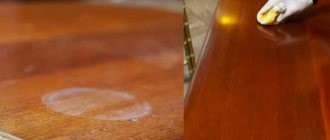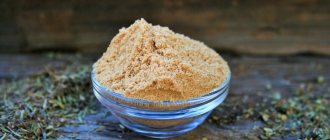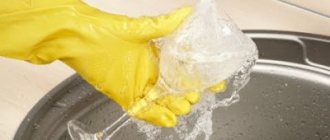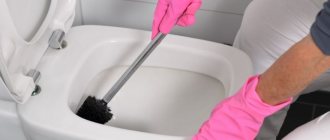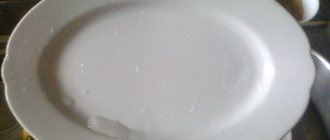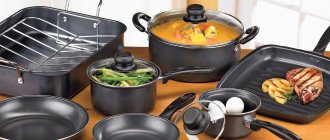Rules for the care of tableware
Rules for washing tableware - instructions and use of products are strictly regulated by disinfection standards in public catering, and are established by Sanitary Standards and Regulations. To implement them, units must be installed that will ensure the correct equipment of the premises for such events.
As a disease prevention measure, special services are trained to check sanitary standards, and you can learn about them from video materials.
And in the article we will describe in detail what measures are taken for such situations.
Top 5 common mistakes
What can you do wrong when doing basic washing of dishes? Here are the top 5 common mistakes:
- Too much detergent. The generous soul of a Russian person does not allow him to put just a drop on a sponge. The result is an excess of surfactants on “cleanly washed” dishes.
- Wash the pan from the inside only. Men often sin with this, trying to rationalize any activity. As a result, even a new frying pan gradually becomes covered with “armor” of soot on the outside.
- Lack of care for glassware. A familiar picture from films is a bartender polishing glasses with a rag. These guys know what they're doing! If you let the glass dry naturally after washing, it will leave traces of drops. Over time, they will turn into a layer of cloudy plaque.
- Using inappropriate equipment. Old rags instead of sponges, hard washcloths and patterned dish brushes - the list goes on. Anything tougher than a typical foam sponge should be used sparingly and only as a last resort. And materials that rot in a humid environment (cotton, for example) are completely prohibited.
- Scraping dried food. The dirty plate had already dried out - and then you remembered about it. Take your time and fill it with water to loosen anything stuck to it.
Washing
The process itself has been known in general terms to everyone since childhood. To begin with, it is worth remembering that it is not recommended to use only a few drops of detergent. And this is far from due to the issue of saving.
It’s just that most detergents are quite difficult to wash, and the more detergent you use, the more difficult it is to wash it.
It is better to change sponges once every 2 weeks, provided that you wash dishes 2 times a day. You need to wash the dishes thoroughly, eating in the most secluded places, so that over time the food does not begin to acquire a strange, specific taste.
Rules
How to properly wash dishes by hand:
- Before washing, all containers must be cleared of food debris. They are thrown into the trash can or toilet. If you don't do this, food will get stuck in the pipe under the sink and cause a clog.
- You cannot wash dishes in bulk; they must be sorted. Greasy plates, pans and pots are washed separately and last. The first to clean are cups, glasses, cutlery, as well as practically clean plates with crumbs.
- Detergents should be used for cleaning. They help wash away stuck pieces of food, dissolve grease and stains.
- To save water, pour it into a large basin and add detergent.
- To save detergent, drop it onto a sponge and foam it. The drop is renewed when the foam stops appearing.
- It is recommended to wash dishes immediately after use. For complex stains, soaking for 8 hours with the addition of cleaning agents is allowed. Otherwise, bacteria actively multiply in leftover food.
- After cleaning in a soapy solution, kitchen utensils must be washed under running water until they are no longer slippery.
- At the final stage, all dishes and the sink are dried. It is best to use an electric dryer. But if it is not there, you can wipe the plates with a towel or place them on a special mesh rack
We recommend: Chemistry without chemicals: I’ll tell you how to easily remove limescale from a tap
What problems with tableware and cutlery can you notice when visiting a restaurant?
- The devices are located in cassettes with handles down. One of the latest such cases was in the Mu-Mu cafe in the center of Moscow. I even made a remark to the staff about this, although my remark was ignored. Even if the handles are up, I hope that these cassettes are washed and disinfected daily.
- I don't like it when the teaspoon is wrapped in a paper napkin, because there is a high probability of hand contact with the device. And it’s good if the staff’s hands were clean.
- Chips in tableware – I see this often, and in my opinion, this is simply the most terrible mistake and the “face of the enterprise” in all its glory.
- Cutlery in a special fabric pocket. Everything is fine here only if these same fabric pockets for devices are washed regularly.
I listed my comments. If you have had similar cases or something else, write in the comments.
Below I will provide links to useful HACCPTRAINER articles that will be useful to all caterers and not only them. For example, an article about whether HACCP is needed in a restaurant, cafe or canteen? or about sous vide technology
To stay up to date with new articles from HACCPTRAINER, subscribe to our Instagram. Link here https://www.instagram.com/haccptrainer/
02/26/2020
Stages
When washing dishes, it is important to maintain consistency. There are only 5 stages:
- Pre-cleaning.
- The washing up.
- Rinsing.
- Drying.
To remove pieces of food, it is best to use a wooden or silicone spatula. Metal objects may leave scratches on the cookware.
Drying
Once you are sure that all the utensils are truly clean, wash your hands and then dry the utensils using a clean towel. Do not use a hand or bath towel as lint may stick to your dishes. Be sure to place cups and glasses upside down on the counter to prevent water from accumulating.
Place the dishes on the shelves after you have dried them. This way, it will be easy to find later and harder to be thrown onto the floor and broken.
Equipment
To wash dishes by hand, you need the following equipment:
- latex gloves;
- foam sponge;
- metal sponge;
- brush.
Gloves protect the skin of your hands from drying out. A foam sponge can be used to remove soft dirt. It also effectively foams the detergent. A metal sponge is used to remove burnt-on pieces of food, and a brush is used to clean bottles, cans and other containers with a narrow bottom.
To wash dishes at home as quickly and comfortably as possible, you can acquire improved equipment:
- brush with detergent reservoir;
- silicone sponges;
- silicone gloves.
The metal sponge should not be used to clean patterned cookware, coated pans, enamel bowls or pans.
The legislative framework
Standard recommendations for washing dishes in preschool educational institutions are set out in the rules developed by SanPiN. They reflect clear requirements that provide for the creation of safe conditions for children.
Following these rules eliminates the possibility of pathogenic microbes developing on kitchen utensils and cutlery and minimizes the risk of the spread of infectious diseases.
The fundamental document regulating all requirements for the catering unit, processing of utensils and equipment is the Resolution of the Chief State Sanitary Doctor of the Russian Federation, as amended to Section XIV under No. 41 dated August 27, 2015 (SanPiN 2.4.1.3049-13 “Sanitary epidemiological requirements for the design, content and organization of the work regime in a preschool educational institution").
General provisions
strictly regulated requirements are imposed on equipment, equipping with a sufficient number of cutlery and kitchen utensils, as well as on the condition of special equipment :
The kindergarten's catering department is provided with the necessary technological and washing equipment that is in good condition (clause 13.1).- All technical means, including cutlery, containers and equipment must be made only from approved materials and must be marked (clause 13.2).
- The catering unit must be equipped with tables on which food products are processed, made of all-metal material (clause 13.3).
- To work with prepared and raw foods, the catering unit is provided with separate tables, knives and boards. (clause 13.3).
- The number of cutlery is strictly in accordance with the roster of children. To store cups and plates, the buffet compartment of each group should be equipped with special lattice shelves and racks. (clause 13.1)
- The washing baths must be supplied with hot and cold water, regulated by mixers (13.5).
- To rinse cutlery, flexible hoses with a spray nozzle (13.6) are provided.
Categorical requirements apply to utensils used for preparing and storing food. The material used must be safe for health.
Dishwashing detergents
What is the correct way to wash dishes? There are several options - good and bad.
- Detergents and cleaning products for dishes.
Household chemicals make washing dishes much easier. They dissolve grease and stains, are easy to use, and are economical to use. Some types of products contain substances that reduce the negative effects on the skin of the hands. The only negative is that they are difficult to wash off and can remain on the dishes.
Powders are used to remove hard dirt, gels are used to wash soft food debris.
Efficiency
10
Ease of use
10
Environmental friendliness
6
- Folk remedies.
It is recommended to wash dishes for allergy sufferers and small children with dry mustard, laundry soap, and soda. They also do their job well, but are not as convenient to use. Significant advantages - they wash off well, do not harm the environment and health.
Efficiency
10
Ease of use
5
Environmental friendliness
10
- Toilet soap, shampoo.
If your home suddenly runs out of dish detergent, you can replace it with shampoo or soap. You need to apply them to a sponge and foam. Washing powder and soap with a bleaching effect cannot be used for these purposes. And remember: this is a temporary measure.
Efficiency
8
Ease of use
7
Environmental friendliness
6
We recommend: How and with what you can wash washable wallpaper in the kitchen - select the product for the type of stains
A little more about cutlery
Remember, I started the article with the fact that the cutlery that was served to me in that cafe was warm? I immediately thought that they were most likely calcined. For example, some cafes serve cutlery in craft bags. It is in these craft bags that the devices are calcined in ovens, bakeries, and dry-heat ovens. Why is it important? A large number of visitors come to the catering point. Someone may have the flu, ARVI, someone may be a carrier of staphylococcal infections. All this remains on the cutlery, so sterilizing it is very important.
Calcination is a thermal method of sterilization.
If the company uses dishwashers, it is good if such machines have a sterilizing effect.

